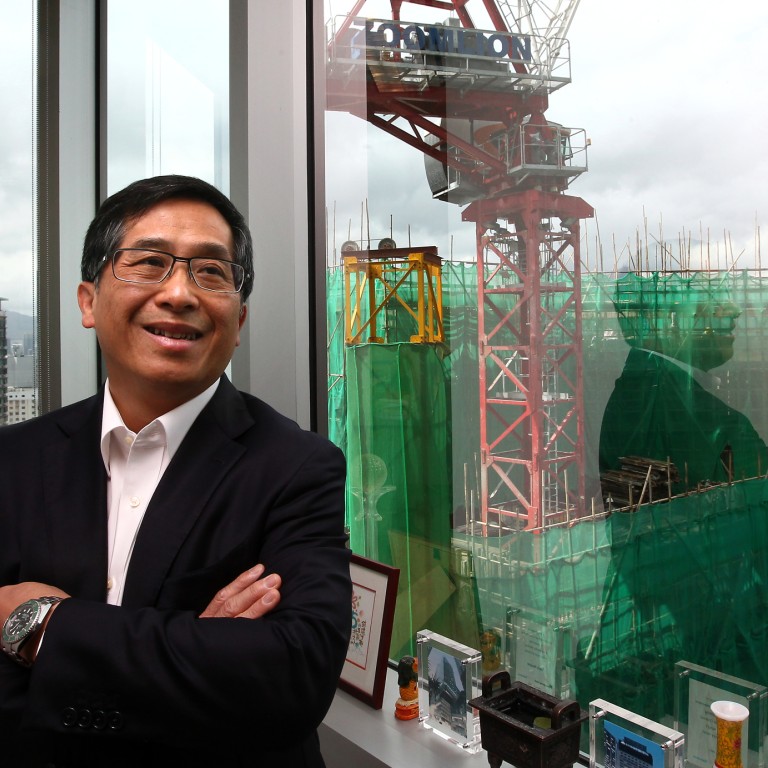
A golden decade for the construction industry
Hong Kong's construction industry is enteringa 'golden decade' with government-directed projects, says Gammon chief Thomas Ho, but rising costs driven by a skills gap are a concern
Gammon Construction was founded in India in 1919. The company has been based in Hong Kong since 1958, after it won the contract to build a new runway at Kai Tak airport in 1955.
The company is currently owned by Jardine Matheson and infrastructure firm Balfour Beatty.
Gammon has become the largest construction company in Hong Kong in terms of market share. Its projects have included the government headquarters at Tamar and the West Kowloon terminus of the MTR Express Rail Link to Guangdong province.
Thomas Ho On-shing joined the company in 1997 and became its chief executive in 2005.
Since the government plans to build 47,000 flats in the long term, and more infrastructure will be built, the coming years will be a "golden decade" for the construction industry.
It is true that infrastructure makes up the bulk of our business. But we will try to make a balance between infrastructure and building construction.
We are more concerned about the quality of our service. We have introduced building information modelling (a system that allows the virtual visualisation of the construction of a building prior to its physical construction) for project management to Hong Kong. It could minimise the waste involved.
We have adopted this technology in the construction of The Forum at Exchange Square. Standard Chartered Bank (the tenant) could use our system for interior design and decoration when they move in.
People have the misconception that main constructors generate lots of profit when construction costs rise sharply.
In fact, the sharp increase in construction costs is mainly because of the rise in the salary of workers. Labour costs eat up a big chunk of profit.
Builders may get more business during a market boom but will not benefit all that much.
If you want to survive, you have to be one of the three largest construction firms in the market. You have to be a local company and be able to build up connections in the city.
On the mainland, the problem of protectionism is a serious one. We expanded to the mainland 30 years ago and built over 100 projects there. But the competition is getting strong.
None of the world's better known construction firms have been able to enter the mainland market over the last 20 years.
Since Hong Kong has plenty of development opportunities, we don't want to waste our talented staff in other markets.
We will not expand as aggressively as we did in the 1990s. We will focus on our business in Hong Kong, Singapore and Vietnam and have no plans to expand elsewhere.
Most construction projects in Hong Kong are world-class projects worth between HK$3 billion and HK$20 billion. And Hong Kong is building five railway links underground or in tunnels; the construction is very complicated.
The MTR Express Rail Link's West Kowloon terminus is more than 30 times as big as an ordinary MTR station. You can imagine how complicated the work is.
Not many people in the world have experience in this kind of construction.
But it is a good time for people to join the industry. You can gain experience from this kind of development. Not many people have the opportunity to build projects like these in their lifetimes.
Most prefabricated components for building flats come from the mainland. But their factories have moved to cities far from Hong Kong. The higher transport charges add to the growth in construction costs.
We should not rely on imports from the mainland. The government could allocate sites for factories to produce prefabricated components.
The government should also release a site for a factory for cutting and bending steel bars. At present, construction firms have to do the work on site. The factory could save time and cost, and the quality and safety could be improved as well.
They will continue to rise unless we are able to import sufficient overseas workers. But it is difficult to forecast how much the construction costs will rise.
It depends on the impact of the shortening of the process for importing overseas workers. If it doesn't help much, the salaries of workers will rise even more sharply.

